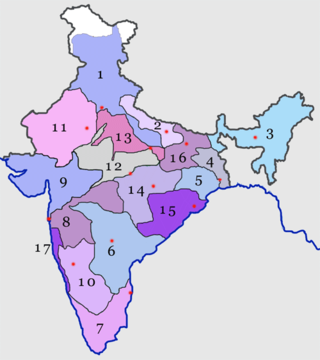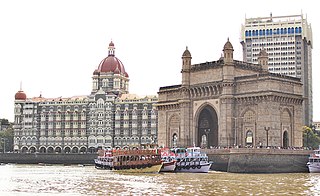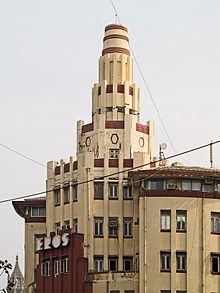
Chhatrapati Shivaji Terminus (officially Chhatrapati Shivaji Maharaj Terminus since 2017, formerly Victoria Terminus (VT), Bombay station code: CSMT (mainline)/ST (suburban)), is a historic railway terminus and UNESCO World Heritage Site in Mumbai, Maharashtra, India.

The Western Railway is one of the 19 zones of Indian Railways and is among the busiest railway networks in India, headquartered at Mumbai, Maharashtra. The major railway routes of Indian Railways which come under Western Railways are: Mumbai Central–Ratlam, Mumbai Central–Ahmedabad and Palanpur–Ahmedabad. The railway system is divided into six operating divisions: Ahmedabad, Vadodara, Rajkot, Bhavnagar, Ratlam, and Mumbai WR. Vadodara railway station, being the junction point for the Ahmedabad–Mumbai route and the Mumbai–Ratlam route towards New Delhi, is the busiest junction station in Western Railways and one of the busiest junctions of Indian Railways too, while Ahmedabad Division earns highest revenue followed by Mumbai Division and Vadodara Division. Surat railway station is one of the busiest railway station in Western Railway in non-junction category where more than 180 trains pass per day.

South Mumbai, colloquially SoBo from South Bombay in Indian English, administratively the Mumbai City District, is the city centre and the southernmost precinct of Greater Bombay. It extends from Colaba to Mahalaxmi, Byculla and Mazgaon neighbourhoods, and comprises the city's old and formerly main business localities, making it the wealthiest urban precinct in India. Property prices in South Mumbai are by far the highest in India and among the highest in the world. In terms of Maharashtra Legislative Assembly, the precinct consists of the constituencies of Colaba, Mumbadevi, Malabar Hill and Byculla.

A resident of Mumbai is called a Mumbaikar. People prefer to stay close to a railway station for easy access to the metropolis. Many city-dwellers lead a fast-paced life with very little time for other activities owing to a significant amount of time spent on daily commuting.

The Rajabai Tower is a clock tower in Mumbai India. It is in the confines of the Fort campus of the University of Mumbai. It stands at a height of 85 m. The tower is part of The Victorian and Art Deco Ensemble of Mumbai, which was added to the list of World Heritage Sites in 2018.

Chennai architecture is a confluence of many architectural styles. From ancient Tamil temples built by the Pallavas, to the Indo-Saracenic style of the colonial era, to 20th-century steel and chrome of skyscrapers. Chennai has a colonial core in the port area, surrounded by progressively newer areas as one travels away from the port, punctuated with old temples, churches and mosques.

The Eros Cinema is an Art Deco style cinema theatre located in Cambata Building at Churchgate, Mumbai, India. It has a seating capacity of 1,204 people per show.

Dadabhai Naoroji Road (D.N.Road), a North–South commercial artery road, in the Fort business district in South Mumbai of Maharashtra, India, is the nerve centre of the city, starting from the Mahatma Phule Market ,linking Chhatrapati Shivaji Maharaj Terminus, leads to the Hutatma Chowk at the southern end of the road. This entire stretch of the road is studded with Neo–Classical and Gothic Revival buildings and parks built in the 19th century, intermingled with modern office buildings and commercial establishments.

The New India Assurance Building is an Art Deco office building made of reinforced concrete and designed by Master, Sathe and Bhuta, with artistic designer N. G. Pansare. It was constructed in 1937 in Mumbai, India for New India Assurance Co. Ltd., an Indian insurance company which was founded by Sir Dorabji Tata in 1919.
The architecture of Mumbai blends Gothic, Victorian, Art Deco, Indo-Saracenic & Contemporary architectural styles. Many buildings, structures and historical monuments remain from the colonial era. Mumbai, after Miami, has the second largest number of Art Deco buildings in the world.
Rahul Mehrotra is Founder Principal of architecture firm RMA Architects of Mumbai + Boston, and is Professor of Urban Design and Planning and Chair of the Department of Urban Planning and Design at the Harvard Graduate School of Design (GSD) in Cambridge, Massachusetts.

Maharashtra state in India is known for its Famous caves and cliffs. It is said that the varieties found in Maharashtra are wider than the caves and rock-cut architecture found in the rock cut areas of Egypt, Assyria, Persia and Greece. The Buddhist monks first started these caves in the 2nd century BC, in search of serene and peaceful environment for meditation, and they found these caves on the hillsides.

Many heritage structures are found in Mumbai, India.

The Victorian Gothic and Art Deco Ensembles of Bombay is a collection of 19th-century Victorian Revival public and 20th-century Mumbai Art Deco private buildings in the Fort precinct of Mumbai. This ensemble was declared a UNESCO World Heritage Site in 2018.
Art Deco Mumbai (ADMT) is a public charitable trust that is actively involved in spreading awareness about Mumbai's Art Deco heritage since May 2016. It is a digital initiative that uses social media and a website to showcase the built heritage. The website is the only repository of information on Art Deco in Mumbai in the public domain.

The Art Nouveau movement of architecture and design first appeared in Brussels, Belgium, in the early 1890s, and quickly spread to France and to the rest of Europe. It began as a reaction against the formal vocabulary of European academic art, eclecticism and historicism of the 19th century, and was based upon an innovative use of new materials, such as iron and glass, to open larger interior spaces and provide maximum light; curving lines such as the whiplash line; and other designs inspired by plants and other natural forms.
Abha Narain Lambah is an Indian conservation architect whose eponymous architectural practice has restored several of India's UNESCO World Heritage Sites like the Ajanta Caves, Golconda Fort and Mahabodhi Temple, and Mumbai's Victorian buildings like the Crawford Market, Royal Opera House, Asiatic Society of Mumbai Town Hall and Knesset Eliyahoo Synagogue.

The Convocation Hall or Cowasji Jehangir Convocation Hall at the University of Mumbai is part of the Victorian buildings complex around the Oval Maidan in Mumbai that is a UNESCO World Heritage Site. It was built between 1869 and 1874, and designed by Sir George Gilbert Scott, who incidentally never visited Bombay and worked from London.
The Art Deco in Kolkata, India is a prominent architectural style which can be found across the city, most notably in the southern parts of the metropolis. The style can be traced back to the 1930s "with the use of Portland cement and with geometrical articulation in plan and cosmetic decorative treatment including perforated concrete grill-work on a simple elevation (façade)." Although Kolkata is notable for its colonial-style and vernacular-style buildings, the emphasis on Art Deco buildings while discussing the architectural history of the city is often overlooked. This is in exception to the few prominent art deco buildings constructed during the colonial period in the first half of the twentieth century—about which enough has been written. Despite art deco being so prominent in the latter half of the twentieth century insofar as entire neighbourhoods—architecturally speaking—appeared to be adaptations of one style, it was not paid enough attention up until the twenty-first century when many such buildings started to be either severely neglected or demolished because of lack of architectural and historical awareness and preservation efforts.
Karfule or Karfule Petrol Pump is a family-run Art Deco fuel station located in Ballard Estate, Mumbai. It was built by Gabriel Sequeira and designed by Art Deco veteran Gajanan B. Mhatre through his firm, Architecture Studio. Karfule was opened for business on October 3, 1938.

















